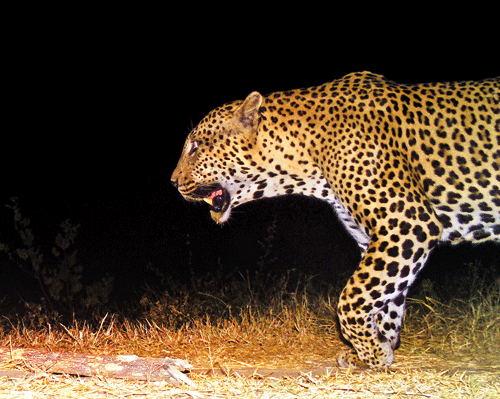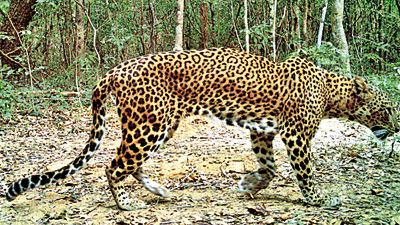Pride and protection must go hand in hand
Being just one of two remaining ‘island-living’ leopards on earth, Sri Lanka’s Big Cat needs ‘stepping stones’ to ensure its survival, a new study conducted
at Wilpattu National Park has found

On the prowl: The large male leopard. Photos courtesy of Dinal Samarasinghe
Sri Lanka is very proud of its one and only Big Cat and apex predator – the magnificent leopard.
The most important measure to safeguard our unique Panthera pardus kotiya for posterity is to provide a high-level of protection within the country’s National Parks (NPs) as is happening now and crucial connectivity to forests adjacent to NPs so that they can roam from one to the other without danger.
This has been established through solid research by a team which has hunkered down in Wilpattu, Sri Lanka’s oldest and Asia’s second oldest formally-declared Protected Area (PA), to study the leopard. Covering an area of 131,693 hectares, this NP on the north-western coast comprises dry lowland forest with a cluster of villus, which are naturally-formed rain-fed water bodies.
Before we delve into the study, we digress and lead author Dinal J.S. Samarasinghe of the Environmental Foundation Limited (EFL) describes how they were awed by the long travels of a big handsome male. “We saw him on a series of camera traps, the ‘master’ of all he surveyed, going from the Talawila area to the Mannar Road and also close to the western mangroves.”
Sri Lanka’s leopard is of special significance because it is just one of two remaining ‘island-living’ leopards on earth, the other being the Javan leopard. Examples of large felid extinctions (wild mammals of the cat family) on islands from across the world include two island populations of tigers (Panthera tigris sondaica) from the islands of Bali and Java and the extinction of the African leopard (Panthera pardus pardus) from Zanzibar. The contributory factors have been loss of habitat due to human expansion, the direct killing of the tigers and also their prey.

Dinal Samarasinghe
“It is important to understand the densities, distribution and dynamics of large carnivore populations to develop effective conservation strategies across landscapes, particularly in island environments,” explains Dinal.
The study titled ‘Evidence for a critical leopard conservation stronghold from a large protected landscape on the island of Sri Lanka’ has been published end-May in the peer-reviewed journal ‘Global Ecology and Conservation’ published by Elsevier.
Dinal and his team had conducted a single season camera trap survey from May 6 to September 16, 2018, with 3,406 camera nights yielding interesting evidence. It has found that Wilpattu has a high density of leopards and that high levels of protection like the landscape at Wilpattu supported this high density. But that alone was not adequate. These leopards also needed safe ‘stepping stones’ to move from very well protected Wilpattu to adjacent areas, be it another protected or even an unprotected area such as Other State Forests – OSFs.
Leopards are very adaptable and can live in environments where there are people. This is why the ‘stepping stones’ should be without disturbance or stress which would hinder their movements.
“This is critical to maintain their genetic integrity as otherwise in an island environment they could face higher extinction risks due to genetic isolation and loss of their finite (limited) habitat,” stresses Dinal, adding that Sri Lanka’s leopards could be an important model for the challenges of island species conservation in the 21st century.
This study can also provide guidance based on scientific evidence to the authorities, the Department of Wildlife Conservation (DWC) and Forest Department (FD) on the way forward, as the leopard represents a critical species for the country’s ecosystem functionality as an apex predator and also revenue-generator for tourism.
The track record in Sri Lanka though has not been too good – human expansion has encroached on essential territory needed for the survival of animals, decreasing and fragmenting forest cover, from 44% in 1956 to an estimated 29.7% in 2021.
Even though, the Wilpattu NP is important for biodiversity conservation as it is connected to a PA complex of reserves under the DWC and FD, there have been pressures and government policies triggering deforestation, encroachment, road development, de-gazettement and downsizing.
This study gives unshakeable proof that not only PAs but their surrounding forests need to be safeguarded.
The study team also comprised EFL’s Eric D. Wikramanayake; Arjun M. Gopalaswamy of Carnassials Global, India; Rukshan Jayewardene & Jehan Kumara of the Leopard Trust; Javana Fernando of Kulu Safaris; Kithsiri Gunawardene of LOLC Holdings; Justine Shanti Alexander of the Snow Leopard Trust of USA & Alexander Braczkowski of the School of Environmental Science and Engineering, Southern University of Science and Technology, Shenzhen, China.
| Some of the key findings | |
| • Wilpattu NP supports a density of 18 individuals/100 sq.km or an abundance of 144 individual leopards in the sample area. • It has a healthy sex ratio of 2 to 1 between females and males. • The estimated activity range for male leopards older than two years was 49.53 sq.km and for female leopards older than two years was 22.04 sq.km. This density falls at the higher end of published estimates for the species anywhere in its global range, based on similar methods. The females needed a safe environment to bring up their cubs and that is why their range was lower, with the males moving out when the area got crowded, underscoring the need for the protection of lands adjoining Wilpattu. • Given Sri Lanka’s limited size, the NP system should be considered a critical stronghold that maintains a source population of leopards, contributing to their long-term survival in the larger landscape.
|
| Unhealthy signs of inbreeding? | |
 Disturbing: Kink at the base of tail The study team is “disturbed” by one factor that raises a red flag. “Among the leopards caught on camera, 12 had kinked (crooked) tails,” says Dinal and they are worried because this could be a danger signal that there is inbreeding (mating of closely related leopards), an indication of an unhealthy population. He underscores that inbreeding occurs when there is inadequate connectivity for them to mix with other populations of their kind in their areas and safe stepping stones are essential for this. Such inbreeding has been found in some mountain lion populations in America like Florida panther, says Dinal, adding that genetic studies would be needed on Sri Lanka’s leopards to confirm whether they are threatened by inbreeding. |
Searching for an ideal partner? Find your soul mate on Hitad.lk, Sri Lanka's favourite marriage proposals page. With Hitad.lk matrimonial advertisements you have access to thousands of ads from potential suitors who are looking for someone just like you.


